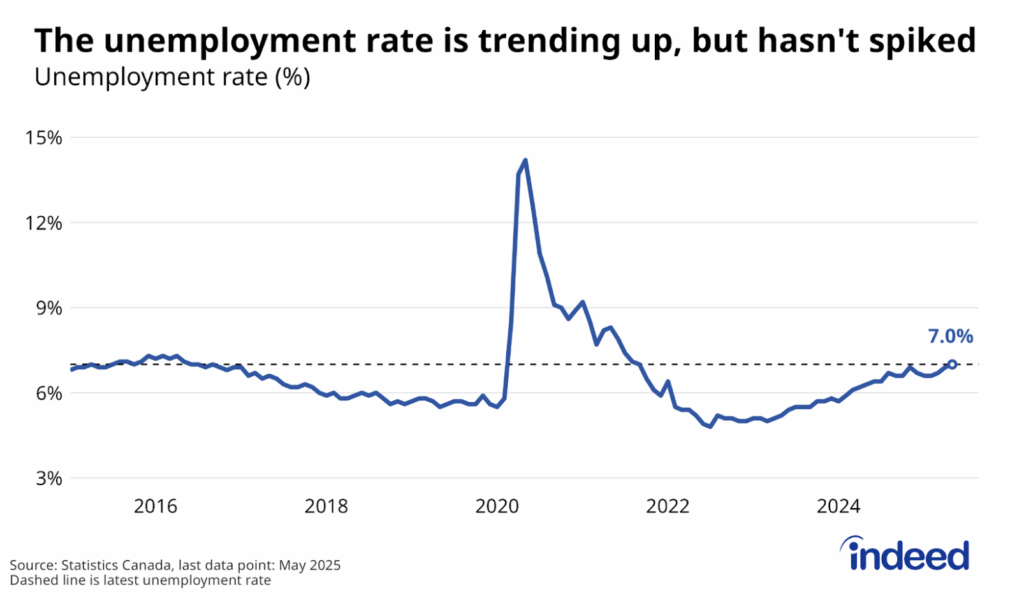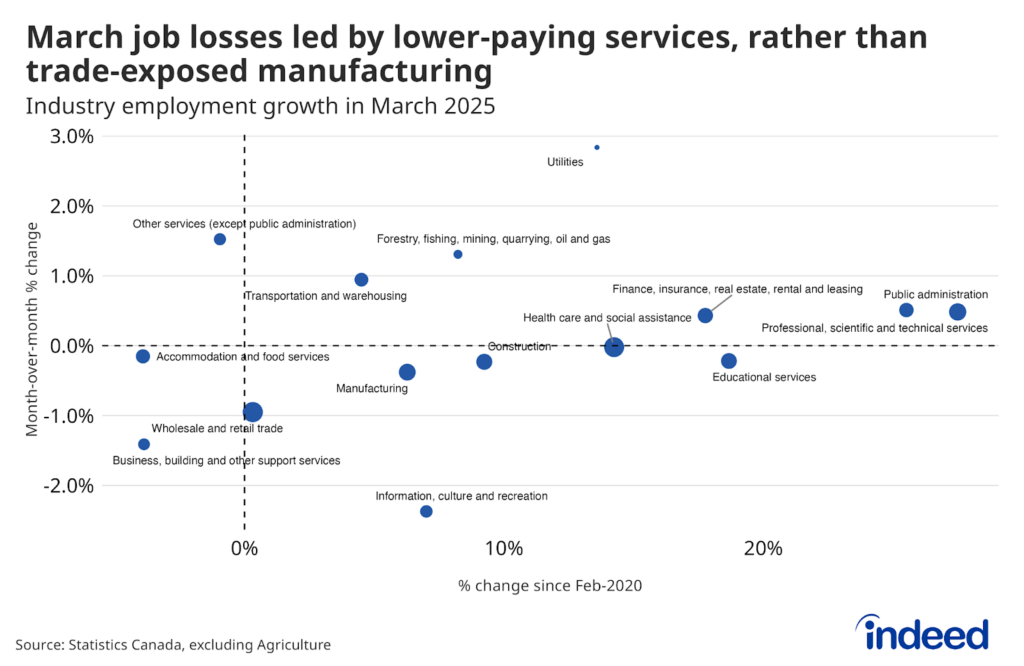Key Points
- Tech job postings on Indeed Canada have made a strong, broad-based rebound after dropping last spring, with particularly large increases for higher-paying and fully-remote positions.
- Earlier in the pandemic, clicks per tech posting jumped compared with the rest of the economy, but have started to fall back as demand for workers has recovered, especially for higher-wage tech jobs.
- Interest in Canadian tech jobs from abroad has remained relatively high throughout the pandemic, but could face more competition from the US as the immigration environment changes there, potentially putting upward pressure on Canadian tech wages.
Canadian tech was among the least scathed areas of the economy early in the pandemic. The monthly job numbers don’t provide a precise sense of tech employment, but all indications are that it has held up fairly well. For instance, at its low point in May, payroll employment in the computer systems design industry was down 2.8% from February compared with a 19.6% drop economy-wide.
Although tech layoffs in the sector were relatively mild, sector conditions were far from normal for much of 2020. Tech job postings on Indeed Canada plunged last spring and remained low through most of the summer, suggesting many employers stopped hiring. Since then though, demand for tech workers has bounced back in a big way.
To track tech postings, we tally ads on Indeed Canada across 657 job titles, both English and French. These roles span a broad range, including software engineering, tech support, and management. In February 2020, tech postings accounted for 7% of total Canadian job postings on Indeed.
The pandemic’s immediate hit to tech job postings was sharp. Between early February and mid-May, they tumbled 39% on a seasonally adjusted basis, modestly better than the 48% decline in the rest of the economy. As the initial shock waned, both tech and overall job postings rebounded, at first tracing similar paths. However, tech momentum picked up in the fall and has continued strongly since. As of March 5, tech job postings were up 30% from last February compared with 5% for other postings.
Higher-paying tech jobs driving the recent surge
The fall and initial rebound of tech job postings was fairly broad based. One way to track this is by grouping tech job titles into similarly sized tiers according to their average annual salaries on Indeed. At the lower end are positions with annual pay averaging below $72,000, including technical support specialist and web developer. Jobs averaging annual pay of roughly $81,000 and above, like technical lead and machine learning engineer, are at the higher end. Mid-paying roles, like software engineer and developer, are between.
Through most of August, job posting trends were similar across the pay spectrum, but since then, higher-paying tech jobs have been particularly strong. On March 5, postings for those jobs stood 48% above their pre-crisis levels, eclipsing the solid but less spectacular 25% and 18% respective gains of lower and mid-paying tech job postings.
The titles driving strong growth in postings for higher-paying tech jobs highlight increasing demand for workers with experience and advanced skills. For instance, growth in postings for senior software engineers has well outpaced the rebound for less senior software engineers. Demand for several managerial positions has also risen, while highly skilled jobs like cloud engineer and software architect are hot. Meanwhile, postings for several tech support roles, which tend to be lower paying and were growing relatively slowly before the crisis, have rebounded less than other areas.
Tech hubs bounce back but remote leads the way
There’s been a noticeable shift in the location of tech job postings during the recent rebound. On the eve of the pandemic, tech opportunities were highly concentrated in just a few hubs. Roughly two-thirds of Canadian tech postings last February were for jobs in the metro areas of Toronto, Montreal, and Vancouver. Ottawa, Calgary, and Kitchener-Waterloo-Cambridge stood further down the list.
Through the dip and subsequent rebound, the tech hiring landscape has grown more diffuse. This isn’t because tech hubs have languished. In fact, tech postings were over 20% above last February’s levels in four of six key metro areas. However, their share of total Canadian tech postings has declined because of a surge in remote work. Pre-crisis, just 2.4% of tech postings had locations either explicitly designated as “remote,” or didn’t specify location. After a brief dip, such postings have more than tripled, rising 223% to now make up 6.3% of the overall sector.
This number represents a lower bound of the real prevalence of remote work in the tech world, since sector job postings often note working from home in job descriptions. Moreover, the lack of a specified location in a job posting suggests remote status may be permanent, or that there might not even be a physical workplace to show up to, differentiating this category from other postings.
The shift toward remote opportunities is intertwined with the faster postings growth among higher-paying tech jobs. In early 2020, postings for lower-wage tech jobs were actually slightly more likely to not indicate a location than other postings. Since then, growth of remote work in higher-paying roles has been particularly strong. This February, 7.7% of high-wage tech postings did not indicate a location, compared with 5.5% of mid-wage jobs and 4.2% of lower-paying roles. In contrast with the pre-pandemic period, employers are increasingly casting a wider net to recruit candidates for openings that are hard to fill.
Hiring conditions for higher-wage roles getting relatively tighter, reversing an earlier shift
Job seeker interest in tech roles has swung substantially since the start of the pandemic. Pre-crisis, tech postings received 39% fewer clicks than the average Canadian job posting, a sign that those openings were relatively tough to fill. However, as the pandemic hit, job seeker interest shifted toward postings for higher-paying, remote-friendly jobs. Tech postings of all types were among the beneficiaries. By mid-summer, the gap between clicks per posting in tech and the overall average had shrunk to 18%.
As employer demand for tech workers has rebounded, the difference between clicks per posting in tech and the rest of the economy has started to widen again. This is particularly the case among higher-wage jobs, where the relative gap is now slightly wider than it was last February, in contrast with mid- and lower-paying tech jobs. Should recent posting trends continue, it could become even more difficult to find candidates for some of these already tough-to-fill roles.
“Biden Effect” might weaken tech job seeker interest from abroad
Rising interest in Canadian tech jobs from abroad was a key trend before the pandemic. Between February 2015 and February 2020, the share of clicks on Canadian tech job postings from jobs seekers located outside the country rose from 9% to 16%. Most of the growth came from outside North America, with India being a key contributor. Growing momentum in the Canadian tech sector and diverging immigration policy direction with the US probably helped spur interest from foreign job seekers.
Surprisingly, the pandemic’s dampening of international travel hasn’t done much to reverse this trend. Even after a slight tick down at the start of the year, 15% of clicks on Canadian tech jobs in February were from abroad, down just one percentage point from a year earlier. This suggests either that foreign tech job seekers are still prepared to navigate the work permit process despite border restrictions or are anticipating that travel restrictions will loosen.
One question is whether Canada’s popularity with foreign tech job seekers will take a hit with a new president in the US. If the Biden administration reverses recent tightening of the H1-B visa program, will some foreign job seekers shift to looking for work south of the border?
In previous research, Indeed found foreign job seekers accounted for particularly high shares of clicks on higher-wage Canadian tech jobs. This segment of the tech job market is getting relatively tighter, and a shift in foreign tech interest to the US would probably further fuel the trend. The result could be slower job growth in certain areas of the Canadian tech sector, but also a potential boost in wages for these roles, which substantially lag pay in the US.
Longer term, the key question is whether such a shift would change tech company decisions about whether to locate in Canada. So far though, foreign interest in Canadian tech remains elevated.
Conclusion
The pandemic might not have cost lots of jobs in the Canadian tech sector, but a plunge in job postings suggest many employers went on a temporary hiring freeze. However, since the early days of the crisis, demand has come back strong and tech job postings are now well above last February’s levels. The rebound has been solid across different job types and regions, but higher-wage roles stand out. What’s more, employers are increasingly looking to fill these positions with fully remote workers.
At the same time, the surge in demand has caused conditions in the tech sector’s higher-wage segment to start tightening relative to the rest of the economy. That could make it harder to fill openings, especially if recent trends continue. Casting a wider net by posting jobs remotely can only ease the situation for employers so much, especially when many of their competitors are also doing so.
With overall demand strong and the potential for stepped-up competition with the US for skilled foreign tech workers, prospects are looking bright for those in the upper echelons of the Canadian tech world. It’s imperative that Canada foster tech talent through formal education and employee development to maximize the number of people able to take advantage of these opportunities.
Methodology
We track developments in Canadian tech jobs by tallying postings of 657 job titles on Indeed Canada and the number of job seeker clicks on these postings over time. Job titles included are positions that have significant responsibilities related to the development, application, or maintenance of information technology.
We divide these job titles into wage tiers by calculating their average annual salaries posted on Indeed since the start of 2020. We then group the titles into tiers of equal sizes based on the number of postings in February 2021. These series are seasonally adjusted using methods similar to those found in our biweekly job posting tracker and presented as seven-day moving averages.
Regions identified as tech hubs refer to Census Metropolitan Areas. For example, a posting located in Mississauga is considered part of Toronto. Job postings with no locations are those where the location of the job is either explicitly described as “remote” or where location is unspecified. Some job postings that mention specific locations might also offer remote options and vice-versa.
We track foreign interest in tech jobs by calculating the share of clicks on employer job postings for tech-related jobs posted on Indeed Canada coming from IP addresses outside Canada.






